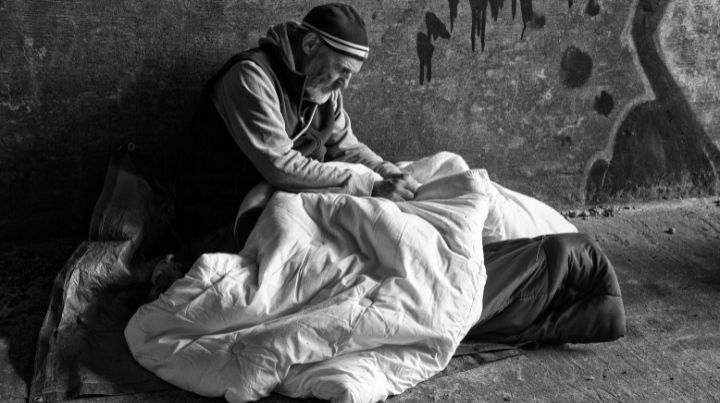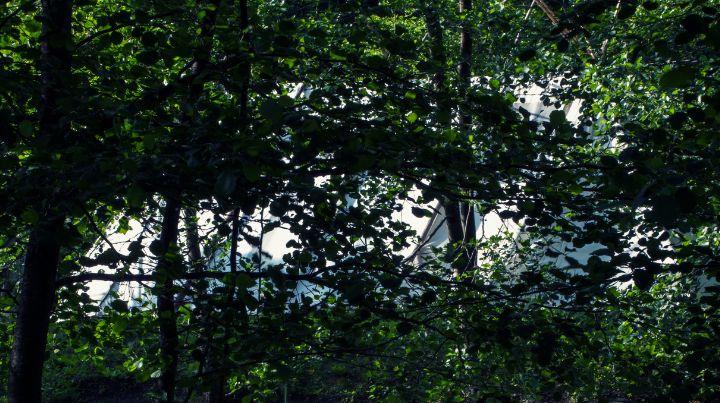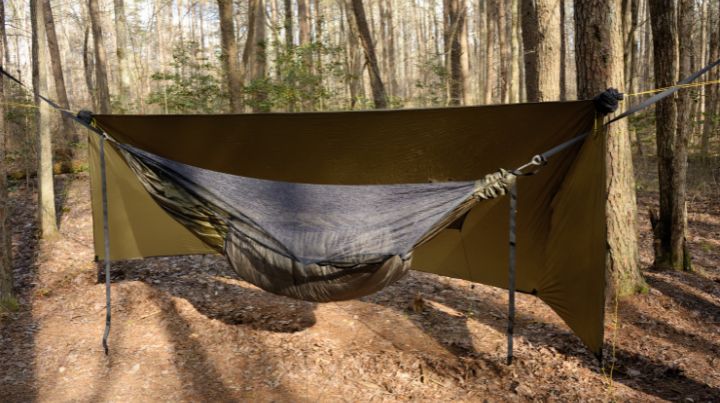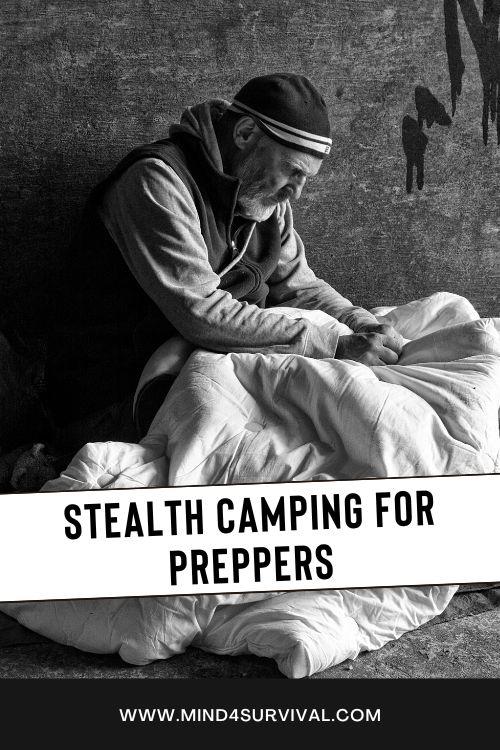What is Stealth Camping and Why It’s Awesome for Preppers

Recently we looked at some training ideas to improve home preparedness. However, when your home is set and it’s time to move outdoors, stealth camping can be a challenging and fun way to improve fitness and boost tactical and self-reliance skills.
Camping can take different styles and forms. Stealth camping, also called tactical camping, is the craft of staying for a short period in public or private lands without getting noticed. It has a strategic emphasis rather than outright wilderness enjoyment, blending traditional outdoor practices with marked tactical considerations.
Staying hidden while resting and refueling means increased safety and energy economy, both critical in most survival situations. Even if you live in a big city and don’t see yourself bugging out, the truth is that we never know – and that’s why we prep. Finally, stealth camping is a good exercise by itself (especially for those who love staying outdoors and active).
Disclaimer: Camping has inherent risks, and stealth camping can have even more. Therefore, it is incumbent upon you to be safe, secure, thoughtful, and legal in all of your camping and tactical stealth camping preps!
Stealth Camping in the City
The urban environment presents numerous places and opportunities for stealth camping, such as parks, green strips, bicycle routes, and other public lands with vegetation, varied terrain, and low traffic of people and vehicles. It’s an option to practice the tactics and techniques, develop urban skills, and discover the best and safest spots in our areas without even having to leave town.
Despite being illegal where I live in Brazil, the recent explosion in the number of people living on the streets means it’s not getting enforced as much. Be mindful, though, that regardless of legality, the local community may call the neighborhood watch or private security to try and dissuade “unwanted visitors” from camping in their area if they see one. So stay under the radar.
Stealth Camping in Rural Areas

These present an appropriate mix of wilderness and semi-urban characteristics, with more places to camp stealthily and fewer people around. Look for spots in or near wooded patches, pastures, farmland, reforestation areas, smaller towns, railroads, and backroads. Strips of land on the roadside with good vegetation and favorable topography might be adequate too. Traditional public campgrounds.etc., aren’t stealthy but offer a safer option to relax, clean up, and get prepped.
When doing bug-out/get-home dry-runs, I camp in all of the above and also under bridges, nearby gas stations, and right off rural dirt roads. I try to avoid trespassing and don’t condone illegal practices, especially if there’s some danger involved. Depending on the circumstances, I ask for permission — even though that negates stealthiness altogether. That, or I pick a hidden spot near a backroad in some public area between farmland.
Stealth Camping in the Wilderness
Lower density, more vegetation, and varied and rough terrain mean a more conventional form of camping, with fewer private lands and people. However, wild animals, bad weather, and accidents are threats to consider. Venturing into the wilderness alone is a no-no. It is advisable only for experienced adventurers and groups.
Stealth Camping Gear
Equipment must be reasonably compact and lightweight, but no need to overcomplicate or go ultra-fancy. A 40-50L backpack with the essentials is enough to cover most situations for two or even more days:
Shelter
The lightest and most compact options are hammock+tarp kit, and one-person (1P) tent-bivvys, like the Snugpack Ionosphere, Stratosphere, or similar. Bivys are low-profile, thus perfect to stay hidden from view and protected from bad weather and bugs. Hammocks and tarps require trees. If you live in places where winter is severe, check with the local camping groups for the best gear and safest practices.
Food and Beverage
Keep it simple and cut the need for equipment, time, and cooking. If protein and granola bars are too dry and bland, prepare a few sandwiches wrapped in tin foil for a convenient and tasty bite. Chocolate bars and some candy are good for quick sugar. A Nalgene bottle or other container to carry water and a portable water filter with some iodine pills to refill. An electrolyte powder mix can hide bad-tasting water and double as a recovery drink.
First Aid
Always carry an Individual First Aid Kit (IFAK), plus some OTC medicines for the most common issues like headaches, diarrhea, and others.
Personal Safety
If concealed carry is not allowed where you live, consider at least a taser or some pepper or bear spray to stave off human or animal threats.
Stealth Camping Gear Extras
- A basic sleeping system with insulation
- Sunscreen
- Bug spray
- Decent knife
- Headlamp
- Battery bank and cables
- Emergency mylar blanket
- Compressed towel pills
- Jacket and extra pair of socks
Stealth Camping Best Practices and Tips
Go Undetected
The objective is to pass undetected. Getting caught is a possibility and can end in one of three ways: people either ignore, act nice, or not. I got invited for a coffee and cornbread a couple of times and only once asked to leave the premises in less polite ways. In my experience, it’s rare to get mistreated.
Safety is #1
Safety is always a concern and would be an issue in the case of a without rule of law (WROL) situation or SHTF. Still, predators, badly intentioned people, and opportunists exist everywhere, even now. Think in those terms to develop the correct mentality and mindset. Be prepared and take all possible precautions.
Location, Location, Location

The campground and its surroundings will dictate the best concealment tactics, such as which camouflage pattern to use.
Finding and picking a good spot is crucial. It must provide concealment and protection. Scan the place for potential risk of floods, fires, thunderstorms, wild animals, poisonous plants, and insects.
Timing is Everything
Arrive at the chosen spot half to an hour early to observe the surroundings before setting camp. That should be enough to get clues and decide whether the spot is good or bad. Set up camp right before dawn, and try to leave at sunrise (or right before) to reduce the chances of getting spotted.
Have a Stealth Camping Bug-Out Plan
It is also an opportunity to lay out a getaway plan. Spend a few minutes scouting potential escape routes, obstacles, dangers, and other hazards. Listen to your gut. With time and experience, we get good and quick at evaluating places.
Ambient Lighting
When stealth camping in the city, look for a dim spot surrounded by well-lit areas. That way, you manage to stay hidden and be able to see around the campsite. It also provides a brighter, safer ground to step on if necessary.
Take the High Ground
Take the high ground: set camp above any nearby roads or trails to stay hidden from view while being able to spot anyone who might try to approach. Avoid crests and ridgelines, which are more exposed to weather and make discerning profiles from a distance easier.
Stay Concealed
Blend with your surroundings. Use earth-toned tents, tarps, and clothes. Dark olive works well in most vegetation types, whether in the wilderness or cities. Camo generally works best in the woods but attracts too much attention in urban environments.
Fire and Light Discipline
Smoke and light draw attention, especially in rural and wild settings. Alcohol and solid fuel produce blue flame and no smoke but must be kept hidden. Canister stoves make no smoke or bright flames but can be noisy.
Use lanterns, headlamps, flashlights, and other light-emitting appliances sparingly, especially in the wilderness or around rural settings where even a smartphone glare is visible from a distance. In cities (and depending on where you are camping), there usually are other lights around to cover our lights, but attention is still necessary.
Stay Alert
Keep your senses unimpeded and alert. Humans are middle-of-the-pack when compared to animal senses, but our sight, hearing, and smell still serve us well. And practice is beneficial: the more we use and rely on our senses, the better they get.
Practice Ahead of Time
Familiarize yourself with your gear to optimize camp setup and takedown. Practice in your backyard or room until you feel confident enough. Always test the equipment first at home before heading out.
Rotate Sites
Rotating spots is paramount. Avoid staying in the same place for two consecutive days or nights. If going for a multi-day trip, map out multiple locations to have options. If caught or even spotted, do not return.
Let People Know
Always tell someone close (a relative, friend, whatever) where and who you’re going with.
Additional Resources
- Invisibility: How to Be a Gray Man
- 25 Best Bug Out Bag Food Items for Survival & Emergencies
- Is It Time to Bug Out? How to Know When to Go
- 10 Best Bug-Out Bag Essentials List & Guide (2022)

Don't Miss Out!
Join the thousands of people who rely on Mind4Survival preparedness advice by subscribing to our FREE newsletter.
- Practical preparedness information
- Zero Spam
- < 0.25% of people unsubscribe




Join Mind4Survival!
Stay informed by joining the Mind4Survival! 100% Secure! 0% Spam!
Follow Us!
Affiliate Disclosure
Mind4Survival is a free, reader-supported information resource. If you make a purchase through our link, we may, at no cost to you, receive an affiliate commission.


Bought his books love them so much great information, times are getting worse (NC) attack on grid .very sad.
Thanks a lot for your comments Keeber. Stay safe and have a great week.
Some observations:
1. If you’re sleeping in a vehicle, besides having blackout curtains (or some equivalents) handy, it also helps immensely to park among other vehicles that will likely remain in place overnight. Parking lots for hospitals, 24-hour grocers, hotels, etc, etc are good places for this strategy. What you don’t want to do is to park far away from any parked vehicles. Your lone wolf strategy would be a red flag warning to any security people to bang on your vehicle once you’ve gone to sleep and order you off of the property.
2. If you snore that’s a dead giveaway to anyone walking by — including security people. It’s worth knowing that there are now little electronic gadgets you can wear that can sense your snoring and give you a signal to change your sleep position to stop the snoring.
3. Not all use of tarps for camping require the presence of trees. See this how-to video for one such interesting example — which only requires 4 tent stakes (although 6 is a little better) plus only one pole. The video example uses a 10 by 10 foot tarp although there are other sized square tarps on the market.
TARP TUTORIAL: No Trees, No Rope, No Problem! Watertight and Windproof Shelter Goes Up In 3 MINS!
Per this 11:38 minute video, from AquaQuest on Nov 24, 2022:
https://www.youtube.com/watch?v=y6sBmEcouV4
https://aquaquestwaterproof.com/
Plus 21 comments, including this one:
Cetok01
3 days ago (edited)
Closing the door on the outside from the inside is just not practical. Why not just pull the fold inside and stake it? Any water would remain inside the fold. Also, I can imagine the condensation issue will be prominent, especially in cold weather and early mornings.
–Lewis
Thanks for the information Lewis, as always it’s helpful and practical. I should’ve made clear that tarps can indeed be used without trees, it’s just hammocks that require them but anyone can camp almost anywhere with just a tarp and a pole that can be made from a branch or whatever. I’ve stealth camped many times using my bike as a tarp support, too.
As for snoring, throughout the years I’ve noticed it depends on where we are… like, in the city it matters little if there’s cars or other noise around. In the woods, it can be muffled by the shelter or even the vegetation. But when we’re camping in a group and someone snores heavily it can indeed be heard from a distance and ruin everyone’s sleeping lol.